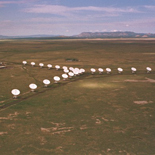
Very Large Array (NRAO/AUI)
UGS - Spring 2010
EXTRATERRESTRIAL LIFE
Unique Nos. 63985, 63990, 63995, 6400, 64005, 64010, 64105, 64020, 64025, 64030, 64035, 64040
Professor
RLM 15.204 · (512) 471-6446 (office), 478-2748 (home) · email
Courses - Spring '10 | Course Website
UGS 303: SCHEDULE OF TOPICS, READINGS, AND EXAM DATES
The course is divided into five sections, with an exam after each section. The exam dates will be provided on a separate handout (soon!). The general plan is: An exam about every three weeks. The exception is Part III, for which we should only need two weeks.
The lectures will mostly follow the sequence of topics in your textbook, indicated by a chapter number in parentheses. In some cases we will not read the textbook section completely, in others the lectures will cover significant supplementary material.
I. Planets and Habitability
Course overview (Evans, Ch1). Drake equation as an organizing tool.
Origin of elements, stars (2, 3A-C). Interstellar molecules.
Origin of planets; observations of protoplanetary disks (3D)
Exoplanet detection*
Habitable planets (3F)*
............Our first exam will occur here (date to be filled in) ..................
II. Transition to the living state by chemical evolution (Evans 4)
Nature of life (4A). Why carbon? Why water?
Origin of the monomers (4B); Miller-Urey experiment, exogenous delivery, …
Rise of the polymers (4C); the problem with DNA; the even larger problem with RNA; importance of
early encapsulation and mineral surfaces.
Rise of the foldamers; the origin of functionality. Why water?
Scenarios for the transition to life (4D). Lipid world, metabolism first,…
RNA world* (more detail than textbook)
Alternative biochemistries (4E) and exotic life forms (4F)
………Second exam here (XXX)………………………
III. Life in the Solar System; Biosignatures (Evans 5)
Some astronomical background: The planets.
Possibilities for life on Venus and Mars
Giant planets, moons, especially Titan.
We will spend only 4-5 lecture periods on this material, with an emphasis somewhat different than in Evans.
...........Third exam here (Thurs. Oct 23)..........................
IV. Development of complex life and civilizations on Earth and elsewhere.
Evolution of biological complexity on Earth. Read Evans 6A as a popularized version of the subject. The Lecture
material here will be nearly independent of the textbook here.
Biological complexity on Earth: Part II.
SPRING BREAK 3/17, 3/19 -> Start reading Contact.
-> Paper topics due
Cultural evolution and technological civilizations (7A)
Lifetime of a technological civilization (Evans 7C, D)
…………Fourth exam here (XXX)……………………….
V. Modes of contact
Drake equation (8)
-> Research papers due
Universality of intelligence? (6B, supplemented).
Strategies for extraterrestrial communication or signal detection (9A-D, E)
Contact (Contact)
-> Paper rewrite due
Possibilities for interstellar travel (10A, B).
Possibilities of past visitations and related phenomena (10C)
............ Fifth (last) exam here, on last class day (XXX)…………
There is no comprehensive final